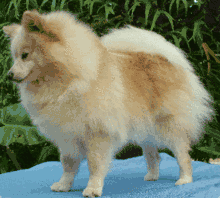German Spitz
German Spitz (or German spitz, plural spitzes or, borrowing from German, Spitze) is used to refer to both a standardized breed of dog (usually capitalized) in some kennel clubs, and a category or type of dog comprising several separate breeds. Various modern breeds have been developed from the original German Spitz, and are either registered as separate breeds or as varieties of German Spitz, depending on club. All German spitz-type dogs are dogs of the broader spitz type, of German origin.
| German Spitz | |||||||||||||||||||||
|---|---|---|---|---|---|---|---|---|---|---|---|---|---|---|---|---|---|---|---|---|---|
 A Cream German Spitz (Mittel) | |||||||||||||||||||||
| Other names | Deutscher Spitz | ||||||||||||||||||||
| Origin | Germany | ||||||||||||||||||||
| |||||||||||||||||||||
| |||||||||||||||||||||
| Dog (domestic dog) | |||||||||||||||||||||
The German Spitz breed
The Fédération Cynologique Internationale recognizes the German Spitz (Deutscher Spitz) under Group 5, Section 4, European Spitz. The Deutscher Spitz is one breed; names differentiate sizes and colour:[1]
- Keeshond or Wolfspitz – wolf grey with black points; 49 ± 6 centimetres (19.3 ± 2.4 in) at withers; ca. 20 kilograms (44 lb).
- Großspitz (Giant or Large Spitz) – white, brown or black; 46 ± 4 centimetres (18.1 ± 1.6 in) at withers; 15 to 20 kilograms (33 to 44 lb).
- German Spitz Mittel (Medium or Standard Spitz, including the American Eskimo Dog) – black, white, cream, brown, sable, particolour and more; 34 ± 4 centimetres (13.4 ± 1.6 in) at withers; 7 to 10 kilograms (15 to 22 lb).
- German Spitz Klein (Miniature Spitz) – white, brown or black, orange, grey-shaded and other colours; 26 ± 3 centimetres (10.2 ± 1.2 in) at withers; 4 to 5 kilograms (8.8 to 11.0 lb).
- Zwergspitz (Dwarf-Spitz or Toy Spitz) or Pomeranian – orange, cream, black, white, sable, particolour, etc. 20 ± 2 centimetres (7.87 ± 0.79 in) at withers; 3 kilograms (6.6 lb).
The German spitz type
Since they are not just one German spitz breed, German spitz (pluralized as spitzes or, from German, as spitze) can also be considered a subtype of the spitz broader dog type. Dogs descended or bred from various German spitzes are included in this grouping.
- The Wolfspitz, also called the Keeshond, is registered as a separate breed by the Kennel Club (UK) and other registries.
- The Großspitz (Grossespitz), also called the Giant Spitz, is 46 ± 4 centimetres (18.1 ± 1.6 in) high and weighs 15 to 20 kilograms (33 to 44 lb). The Wolfspitz and the Giant Spitz are divided primarily by colour, though the Keeshond tends to have a fuller coat and is taller and heavier.
- The Mittelspitz, also called the Medium Spitz or Standard Spitz, is the ancestor of, and is sometimes taken to include, the American Eskimo Dog. The latter is allowed to be registered as Mittelspitz by some registries. Only the Canadian Kennel Club and the two major American kennel clubs recognize the American Eskimo Dog as a separate breed.
- The German Spitz Klein, sometimes known as the Kleinspitz or Miniature Spitz, is allowed more colours than the larger German spitz varieties, under the Fédération Cynologique Internationale standard. The Japanese Spitz, also bred from German spitz stock, is very similar to the Spitz Klein but is limited to the white colour and has a different breed history.
- The Zwergspitz, also called the Toy Spitz or the Pomeranian, is also registered as a separate breed in the UK and North America.
The Kennel Club (UK) and the Australian Kennel Club recognize only the Kleinspitz and Mittelspitz. In those countries, the Grossespitz is not recognized, and the Pomeranian (Zwergspitz) and Keeshond (Wolfspitz) are separate breeds. In many countries the Miniature (Klein) Spitz is also confused with the Pomeranian (Zwergspitz). Some registries and breed clubs allow various sizes of German spitzes to be interbred, others do not.
Appearance
German spitzes are similar in appearance but vary in colour. The German Spitz breed is usually black, gold/cream and black, or white-ish; but the Standard, Small, and Dwarf can have various colour combinations as well. All German spitzes have a wolf- or fox-like head, double coat, high-set triangular ears, and a tail that is curled over the back. Although the Kleinspitz and the Pomeranian look similar, they are not the same dog.
History
Genetic evidence places spitz-type dogs in a recent lineage, dating the Wolfspitz type to the 19th century.[2]
When German spitzes were brought to the US, these were renamed the American Eskimo Dog due to widespread anti-German sentiment during World War I, although other breeds ("White Keeshonds" and Pomeranians, along with Japanese Spitz) were also used in the formation of the American variety. The American Kennel Club recognizes the breeds as separate.
References
- Fédération Cynologique Internationale website Archived 12 October 2006 at the Wayback Machine (accessed 06 September 2010)
- Ostrander, Elaine A. (September–October 2007). "Genetics and the Shape of Dogs: Studying the new sequence of the canine genome shows how tiny genetic changes can create enormous variation within a single species". American Scientist. p. 4. Retrieved 22 September 2008.
External links
| Wikimedia Commons has media related to Deutscher Spitz. |